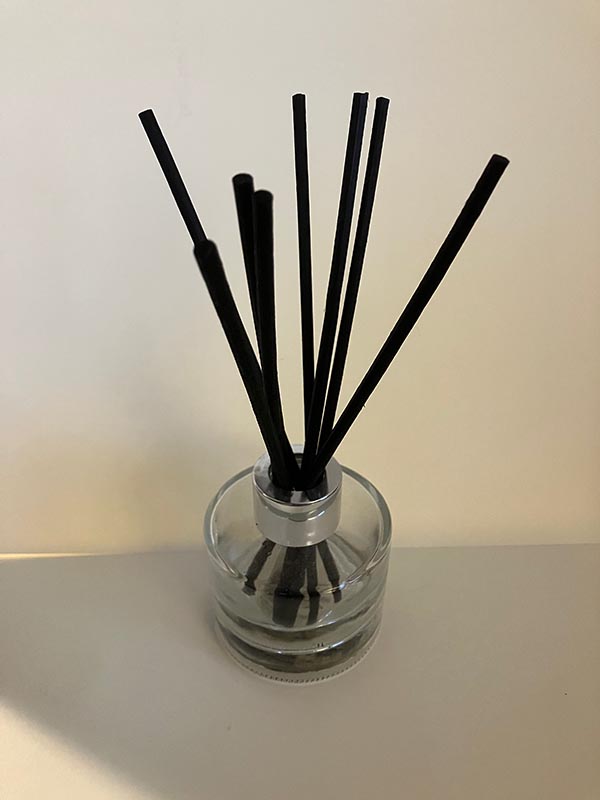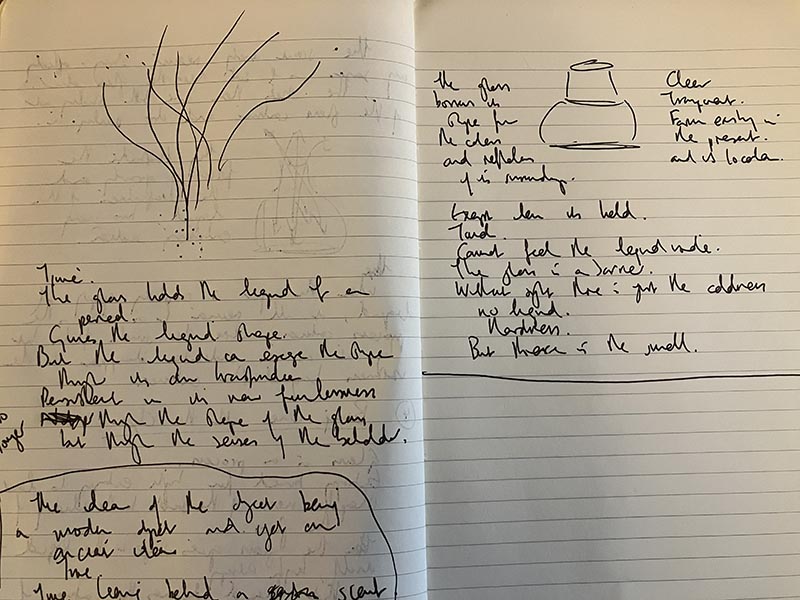After writing about the empty diffusers I found in my late mum’s house, I’ve been wondering about how I might use them in a work. One of the strategies I learned on my MA (2006-08) was Goethean observation; a process I have used many times before and which I decided to use again with these objects. The method of observation can be found below.
Observation: Diffuser
1. Exact Sense Perception [Perception]
On first seeing the object it becomes apparent there are two main parts to it. One, a glass jar/container and second, eight black wooden sticks. The sticks are placed inside the container and protrude from the top several inches.
The glass container is approximately 3 inches in height and inside is a liquid; not much – just a few millimetres. The bottom of the sticks rest on the bottom of the container and in the liquid which coats the bottom of the sticks. There is some writing on the glass container which includes a description of the obvious scent coming from the container.
Placing my nose near the opening at the top of the container, the smell is very strong and quite overpowering.
I can see the lights of the room I am sitting in and that from the window reflected in the silver stopper at the top of the jar and in the glass; with highlights on the shoulder of the glass container and again in the stopper.
I can feel my nose – full of the scent which becomes increasingly strong; almost too much.
I can hold the container in my hand. Looking at it from below I can see the viscous liquid move about the base. It is goldish in colour and syrupy.
Holding one of the sticks they are about 12cm long. One end is wet with the liquid, the other dry but there is a dry kind of stickiness to it. When I place the stick back in the glass container I can feel something on my finger. It smells like the scent from the bottle.
There are lots of reflections in the jar and the stopper; the brown of the table, the lights I’ve already mentioned; reflections of the sticks in the silver surface of the stopper.
I can see the base of the sticks through the glass of the jar, their shape distorted especially at the shoulder of the container.
Leaning back I can see the liquid on the base of the sticks catching the light in the room and from the window. The sticks form a random pattern as they stick out of the container, like fingers reaching out.
2. Exact Sensorial Fantasy [imagination]
Looking at the objectI think of its two parts; the glass container and the wooden sticks standing inside. To begin, I take the sticks out of the jar ad place them on the table beside me.
These two materials then are quite different entities. And there is the liquid too, created in a factory somewhere from all kinds of different scents – only some of it remaining in the bottom of the jar. The jar, as it stands on the table before e, looks empty – reflecting just the room round it. Only when I pick it up is the liquid apparent.
The liquid then must have once filled the container; the liquid created by people who could smell when the recipe was right, when a satisfying smell had been created.
The smell lingers; remaining strong even though so much of the liquid has gone; evaporated through the same hole through which it was poured before being sealed up.
The glass itself comprises ingredients mixed together to create the material. Although the object exists now, the method itself is ancient.
As is the idea of scented oil. There is something ancient about the glass jar – the idea of the container and the scented oil. The smell I can smell is strong and in that sense is something equally ancient.
The glass container and the liquid inside are a version of something much older,
The wooden sticks are products of trees; things grown, reaching toward the sky, year after year after year.
The wood from the tree has been turned into these small sticks and brought together with the container and its contents to help spread the aroma of the liquid.
The liquid will, in a short time, disappear leaving behind an empty jar – but one which is nevertheless full of scent which will remain for much longer.
The sticks will disappear before the glass jar and what had been 3 things will be one. The sticks will have gone; the liquid will have gone and all that will be left is the jar – and yet there will still be the scent. The jar is still full – and yet there will still be the scent. The jar is still full; an emptiness transformed into something else.
3. Seeing in Beholding [Inspiration]
An almost invisible transformation
Very slowly the liquid disappears into the air around the container.
It attached too to the glass and the sticks
The liquid leaves the jar and yet it remains, still able to affect the senses.
The container can never be empty.
Not entirely.
The liquid does not entirely disappear.
The sticks point upwards, drawing up the liquid; freeing some of the scent.
The rest remains inside.
There are two forces at work. Gravity keeps the glass container on the table and the sticks inside the jar. The scent evaporates into the air leaving the bottle while some of the scent remains inside.
Te scent itself remains strong – affecting my senses as I sit near the glass container. The sticks then are both sticking out of the glass container ad also pointing in.
They illustrate the forces of gravity and the evaporation of the liquid; two very contrasting actions.
When the jar is completely empty of liquid, it will remain for as long as the process continues, when the smell fades bit by bit as its molecules disappear into te vastness beyond the container.
4. Being One with the Object [Intuition]
Glass is a process.
Entropy.
Turned from high entropy to low.
Shapelessness of the smell to the solidity of the glass.
The glass gives shape to the liquid – itself high entropy.
That liquid becomes the confines of its shape.
It disappears and leaves behind its smell.
That smell forms a shape in the mind.
Time.
The glass holds the liquid for a period.
The shape of time.
Gives the liquid shape.
The liquid escapes the shape through its own transformation.
Resilient in its new formlessness.
The glass itself borrows its shape from the colours and reflections of its surroundings.
Clear.
Transparent.
Its form borrowing from the present and its location.
Except when its held.
Touch.
Cannot feel the liquid inside.
The glass is a barrier.
Without sight there is just the coldness.
No liquid.
Hardness.
But there is the smell.


